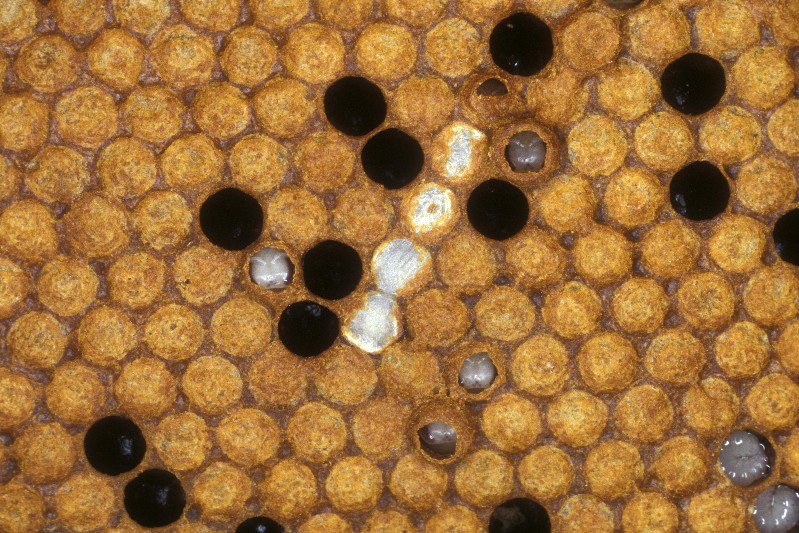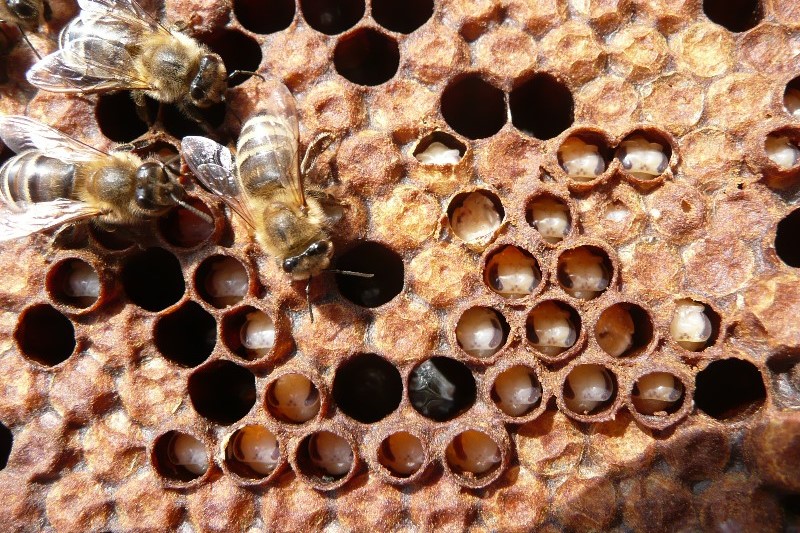I Spy….. Getting your eye in. 7th June 2025
Thanks to all those who came to this meeting and asked all the questions. We hope you benefited from the discussions and will put some of the hints and tips to good use in your own hives. As promised, I have duplicated the Task Sheet and put together some notes on possible answers / scenarios to act as prompts when you are working your own bees. There is also a down loadable PDF you can use.
⪻ ※ ※ ※ ※ ※ ⪼
We will start with 20min – 1/2 hr chat to explain what this exercise is all about.
Normally, you would be divided into groups and allocated a hive to study plus an experienced beekeeper to guide you. The weather put paid to that!
In your own apiaries, follow the Task Sheet questions and make notes as you go if you wish. See if you can spot the situations mentioned and incorporate them into your routine. Please note, one thing that was not discussed at the meeting is the information gleaned from any bald brood found in the hive. See the notes in the table below.
Task Sheet (left hand column) and some possible observations or deductions (right hand column)
Before opening the hive
Observations/Deductions
What can you predict from this information?
Record says low on stores, weather poor – MAY NEED TO FEED
Record says good stores, weather fine – MAY NEED TO ADD SUPER(S)
Implications?
Oil seed rape out now, will cease soon – BAD TEMPER!
Not much out at the moment, but nectar flow may start soon – watch SPACE in supers and ADD boxes in plenty of time.
Air temperature?
Pollen loads?
Drones?
Nectar loads?
10℃ minimum for bees to emerge.
Pollen loads easy to spot.
Drones, indicator of swarm possibility. Check in brood box.
Nectar loads, honey stomach full, legs hanging down.
Robber bees?
Asian hornets
Robber bees enter hive empty (legs up), and leave full (legs down).
Hawking behaviour
Distribution of debris?
Mites?
Significance of dark cappings and/or white cappings in debris?
Count different coloured pollen loads.
Count mites and give average daily mite drop.
Dark cappings are from brood comb therefore bees emerging.
White cappings are from honey stores therefore bees actively using stores.
How many different pollen colours? 6 or more should give adequate nutritional diversity.
Signs of:
a) Vairimorpha (Nosema)
b) ABPV
c) DWV
Fanning
a) Diarrhoea streaks
b) Shiny bees and quivering bees
c) Deformed wings
Nazanov gland not visible – fanning for temperature/humidity control
Nazanov gland open – colony has been disturbed.
After opening hive
Observations / Deductions?
Crowded or uncrowded?
Space for queen to lay?
Should be space for queen to lay: do you see pollen blocking or solid stores?
Do bees have enough space to process and store nectar / honey?
Are extra supers needed?
Add new super under existing super or above? Discuss.
Brood in all stages (MUST see eggs)
Queen present?
How many drones? (a few, fair number, lots)
Queen cells or cups?
What is your assessment?
Drone numbers may indicate likelihood of swarming.
Dry cups or cells are nothing to worry about at present. Only need to take action if cells are charged with royal jelly/larvae.
– Perforated cappings,
– Sunken cappings,
– Larvae that ‘don’t look right’,
– Chalk brood,
– Deformed wings,
– Sac brood,
– Bald brood – a sign that bees may be uncapping brood to deal with varroa.
Check for queen before shaking.
Make sure you recognise the difference in bald brood from wax moth damage and uncapping varroa mites.

Images Courtesy The Animal and Plant Health Agency (APHA), Crown Copyright

If so, what is going on?
Ideally, provide somewhere for them to lay drones from April onwards.
Discuss alternatives, half frame, drone foundation.
Maybe the bee space is wrong.
– New queen still learning.
– Old queen fading.
– Disease or old comb.
– (Diploid drones)
Comment on findings.
If no eggs, could be swarm preparations, dearth of forage, poor weather (or need new glasses!).
What is bee space in supers?
Spacing for new foundation.
1 bee space for supers.
Standard Hoffmann spacing is 35mm.
Thanks to the experienced beekeepers for their contribution to the discussions. Feedback on the session was positive.